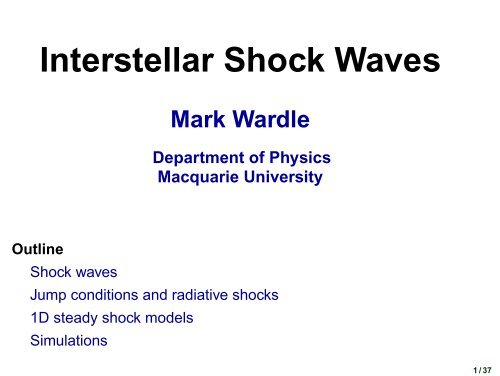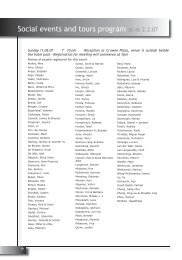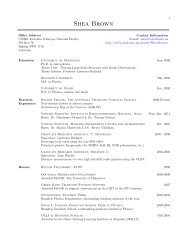Interstellar Shock Waves Mark Wardle
Interstellar Shock Waves Mark Wardle
Interstellar Shock Waves Mark Wardle
Create successful ePaper yourself
Turn your PDF publications into a flip-book with our unique Google optimized e-Paper software.
<strong>Interstellar</strong> <strong>Shock</strong> <strong>Waves</strong><br />
Outline<br />
<strong>Shock</strong> waves<br />
<strong>Mark</strong> <strong>Wardle</strong><br />
Department of Physics<br />
Macquarie University<br />
Jump conditions and radiative shocks<br />
1D steady shock models<br />
Simulations<br />
1 / 37
<strong>Shock</strong> waves<br />
• Rapid motion: fluid cannot move away until overrun by a<br />
disturbance<br />
• Scattering converts unshocked gas to shocked gas<br />
– compresses and heats gas<br />
– entropy is increased<br />
2 / 37
Terrestrial shock waves<br />
3 / 37
4 / 37
5 / 37
Astrophysical shock waves<br />
• Cosmic violence: shock waves are common<br />
sound speed: cs =<br />
� kT<br />
m<br />
�<br />
T /1000K<br />
≈ 3km/s ×<br />
m/mp<br />
� 1/2<br />
Alfvén speed: vA = B<br />
B/µG<br />
� ≈ 2 km/s ×<br />
4πρ (nH/cm−3 ) 1/2<br />
– stellar winds, cloud collisions, supernovae, accretion, jets, . . .<br />
• <strong>Shock</strong> waves process the gas<br />
– change density, velocity and temperature<br />
– affect ionization state, destroy dust grains, drive chemistry<br />
– introduce structure into the fluid<br />
– particle acceleration<br />
– shocked gas radiates!<br />
6 / 37
Accretion<br />
7 / 37
Compact HII region / cloud collisions<br />
8 / 37
Stellar wind<br />
9 / 37
IC 443 supernova remnant<br />
10 / 37
IC 443 – 2MASS<br />
11 / 37
SNR E0102-72<br />
12 / 37
Protostellar jets<br />
13 / 37
Jump Conditions<br />
unshocked gas at rest<br />
shock frame<br />
• Conservation of mass, momentum and energy fluxes across shock<br />
front<br />
ρv<br />
ρv 2 + P + B2<br />
8π<br />
�<br />
1<br />
2 ρv 2 + γP<br />
γ − 1<br />
+ B2<br />
4π<br />
�<br />
v<br />
Bv 14 / 37
Strong shocks<br />
• For vs ≫ vA, cs and γ > 1 the jump conditions reduce to<br />
ρ2<br />
ρ1<br />
= B2<br />
=<br />
B1<br />
v1 γ + 1<br />
≈ = 4 (for γ = 5/3)<br />
v2 γ − 1<br />
T2 ≈ 3 mv<br />
16<br />
2 s<br />
k<br />
≈ 1.4 × 105 �<br />
vs<br />
100km/s<br />
• Magnetic fields hardly affect the jump<br />
– but if the gas is ionised, their presence leads to particle acceleration<br />
which can significantly increase the compression ratio<br />
– and limits the compression of the gas as it cools<br />
– you have been warned<br />
�2<br />
K<br />
15 / 37
Radiative shocks<br />
• <strong>Shock</strong>ed gas radiates away energy, so T drops<br />
• Total pressure, P + B 2 /8π is constant in the postshock gas<br />
• Initially, thermal pressure dominates magnetic pressure<br />
– ρ increases to compensate for drop in T<br />
– B 2 /8π increases as ρ 2<br />
• Magnetic pressure kicks in and halts further compression<br />
– cool gas forms a dense layer<br />
B2 8π ≈ ρ1v 2 s =⇒ ρ<br />
√<br />
2vs<br />
≈ ≫ 1<br />
ρ1<br />
vA<br />
16 / 37
Steady, 1D shock models<br />
• Follow a fluid element as it passes through the shock and drifts<br />
downstream<br />
– ρ, v, T , B<br />
– dissociation, ionisation, recombination, chemistry<br />
– cooling function Λ(ρ,T )<br />
– internal excitation: level populations<br />
• A set of ordinary differential equations describe structure of<br />
shocked gas<br />
– local effects only: integrate an initial value problem<br />
– for vs > 100km/s, shock-generated radiation gives rise to non-local<br />
coupling: iterative methods<br />
– “trivial” problem compared to fluid simulations<br />
• When does the structure of the shock front matter?<br />
– particle acceleration in collisionless shocks<br />
– vs < 45km/s shocks in molecular clouds (C-type shocks)<br />
17 / 37
Atomic shocks<br />
Sutherland & Dopita 1996<br />
18 / 37
Atomic shock - structure<br />
Sutherland & Dopita 1996 19 / 37
J-type shocks in molecular clouds<br />
20 / 37
Hollenbach & Mckee 1989<br />
21 / 37
C-type shock waves in molecular clouds<br />
• Molecular clouds are strongly magnetised<br />
– magnetic pressure ∼ 100 times the gas pressure<br />
– vA ≈ 2km/s, cs ≈ 0.2km/s<br />
• Molecular clouds are weakly ionised<br />
– cosmic-ray ionisation vs recombination: ne ∼ 10 −7 n(H2):<br />
• Magnetic fields only act on charged particles<br />
– forces charged particles to drift through the neutrals<br />
– collisions communicate magnetic forces to the neutral gas:<br />
– “ambipolar diffusion”<br />
J × B<br />
c<br />
= αρρivi<br />
22 / 37
23 / 37
C-shock structure<br />
Kaufmann & Neufeld 1996 24 / 37
Line emission<br />
Kaufmann & Neufeld 1996 25 / 37
Instability<br />
<strong>Wardle</strong> 1990<br />
26 / 37
Saturated state (2D)<br />
Neufeld & Stone 1997<br />
27 / 37
Thermal instability<br />
Sutherland et al 2003<br />
28 / 37
Fig. 12.—Two-dimensional shock time-evolution snapshots. Panels 1–12 show the density variable in the power-law density spectrum shock model at<br />
evenly spaced time intervals (2 10 10 s) throughout the simulation. The postshock gas is at times relatively smooth (1, 5, 8, 10), during the approximately<br />
adiabatic buildup of the shock before cooling initiated collapse occurs. The visible fluctuations result from shock compressed initial fluctuations.<br />
Subsequently, (2, 6, 9), the fluctuation contrast increases and dense filaments form (3, 7) along with low-density voids. The shock then collapses with the loss<br />
of internal pressure support (4).<br />
Sutherland et al 2003<br />
29 / 37
<strong>Shock</strong>s hitting clouds<br />
Xu & Stone 1995<br />
30 / 37
3D<br />
Xu & Stone 1995<br />
31 / 37
NOVA experiments<br />
Klein et al 2003<br />
32 / 37
2D vs 3D<br />
Klein et al 2003<br />
33 / 37
3D AMR<br />
Klein et al 2003 34 / 37
2D Cartesian with B<br />
Fragile et al 2005<br />
35 / 37
Fragile et al 2005<br />
36 / 37
Summary<br />
• <strong>Shock</strong> simulations: what should you worry about?<br />
– Adiabatic vs radiative<br />
– Magnetohydrodynamics vs hydrodynamics<br />
– Dimensionality<br />
– Geometry<br />
– Boundary conditions<br />
• If you are involved with large-scale simulations that contain shocks<br />
what should you be really worried about?<br />
– small-scale shock instabilities<br />
– subtle aspects of MHD<br />
37 / 37










